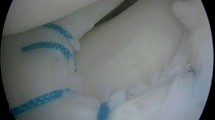Abstract
Purpose
Symptomatic discoid lateral meniscus without tears has traditionally been treated with excision of part or the entire meniscus. Resection of 15–34% of the meniscus increases tibiofemoral contact pressures by more than 350%. Treatment of discoid lateral meniscus with partial or total meniscectomy in childhood increases the risk of early-onset osteoarthritis in the knee. The incidence of osteoarthritis is directly proportional to the amount of meniscal tissue resected. This paper describes the meniscus-preserving technique of meniscopexy and presents the outcomes of all patients who have undergone this procedure in the management of lateral discoid meniscus in a single unit over a 14-year period.
Methods
A retrospective study was carried out reviewing all patients who underwent meniscopexy for the treatment of MRI-confirmed discoid lateral meniscus without meniscal tear between 2001 and 2015 with a minimum of 1-year follow-up. Eleven patients (12 knees) were identified using a patient database of all patients that had undergone this procedure in our institution. Two patients were excluded from the final results, so nine patients (10 knees) were scored post-operatively at last follow-up using the Lysholm knee score. We reviewed all available post-operative MRI scans and recorded any complications.
Results
Four patients were male and seven were female. The median age of the patients at the time of surgery was 9 (6–14), and the median follow-up was 4.5 years (2–14). The median Lysholm knee score was 91 (86–100). The outcome for all patients scored was either good or excellent.
Conclusion
The established treatment options for symptomatic discoid lateral meniscus without associated tear involve resection of meniscal tissue. Using this technique, all the meniscal tissue is preserved, thus reducing the risk of arthritic change in the future. MRI studies performed post-operatively suggested normalisation of meniscal morphology with time. Meniscopexy offers an effective alternative to the established treatment options in the management of symptomatic discoid lateral meniscus without meniscal tears.
Level of evidence
IV.



Similar content being viewed by others
References
Ahmed AM, Burke DL (1983) In-vitro measurement of static pressure distribution in synovial joints—part I: tibial surface of the knee. J Biomech Eng 105:216–225
Ahn JH, Kim KI, Wang JH, Jean JW, Cho YC, Lee SH (2015) Long-term results of arthroscopic reshaping for symptomatic discoid lateral meniscus in children. Arthroscopy 31(5):867–873
Aichroth PM, Patel DV, Marx CL et al (1991) Congenital discoid lateral meniscus in children: a follow-up study and evolution of management. J Bone Joint Surg Br 73:932–936
Anderson-Molina H, Karlson H, Rockborn P (2002) Arthroscopic partial and total meniscectomy: a long term follow-up study with matched controls. Arthroscopy 18(2):183–189
Baraz ME, Fu FH, Mengato R (1986) Meniscal tears: the effect of meniscetomy and of repair on intraarticular contact areas and stress in the human knee. A preliminary report. Am J Sports Med 14:270–275
Dickhaut SC, DeLee JC (1982) The discoid lateral meniscus syndrome. J Bone Joint Surg [Am] 64:1068–1073
Fujikawa K, Iseki F, Mikura Y (1981) Partial resection of the discoid meniscus in the child’s knee. J Bone Joint Surg Br 63:391–395
Gilbert RE, Gallacher PD, Roberts AP (2010) Meniscopexy (anterior horn transfer) for discoid lateral menisci. Ann R Coll Surg Eng 92:257–258
Harato K, Niki Y, Nagashima M, Masumoto K, Otani T, Toyama Y, Suda Y (2015) Arthroscopic visualization of abnormal movement of discoid lateral meniscus with snapping phenomenon. Arthrosc Tech 4(3):235–238
Hayashi LK, Yamaga H, Ida K et al (1988) Arthroscopic meniscectomy for discoid lateral meniscus in children. J Bone Joint Surg Am 70:1495–1500
Jordan MA, Duncan JB, Bertrand SL (1993) Discoid lateral meniscus: a review. South Orthop J 2(4):239–253
Kelly BT, Green DW (2002) Discoid lateral meniscus in children. Curr Opin Pediatr 14(1):54–61
Kocher MS, Klingele K, Rassman SO (2003) Meniscal disorders. Normal, discoid and cysts. Orthop Clin N Am 34:329–340
Lee C, Song I, Jang S, Cha H (2015) Results of arthroscopic partial meniscectomy for lateral discoid meniscus tears associated with new technique. Knee Surg Relat Res 25(1):30–35
Nathan PA, Cole SC (1969) Discoid meniscus. A clinical and pathologic study. Clin Orthop Relat Res 64:107–113
Raber DA, Friederich NF, Hefti F (1998) Discoid lateral meniscus in children: long-term follow-up after total meniscectomy. J Bone Joint Surg Am 80:1579–1586
Rosenberg TD, Paulos LE, Parker RD et al (1987) Discoid lateral meniscus: case report of arthroscopic attachment of a symptomatic Wrisberg-ligament type. Arthroscopy 3(4):277–282
Seedholm BB, Hargreaves DJ (1979) Transmission of the load in knee joint with special reference to the role of the menisci. Eng Med 8:220
Sharma R, Sinha R, Menon P (2010) Meniscopexy for internal derangement of temporomandibular joint. J Maxillofac Oral Surg 9(3):261–265
Tegner Y, Lysholm J (1985) Rating systems in the evaluation of knee ligament injuries. Clin Orthop Relat Res 198:43–49
Vandermeer RD, Cunningham FK (1989) Arthroscopic treatment of the discoid lateral meniscus: results of long-term follow-up. Arthroscopy 5:101–109
Watanabe M, Takeda S, Ikeuchi H (1979) Atlas of arthroscopy, 3rd edn. Igaku-Shoin, Tokyo
Wroble RR, Henderson RC, Campion ER et al (1992) Meniscectomy in children and adolescents. A long-term follow-up study. Clin Orthop Relat Res 279:180–189
Yaniv M, Blumberg N (2007) The discoid meniscus. J Child Orthop 1(2):89–96
Author information
Authors and Affiliations
Corresponding author
Ethics declarations
Conflict of interest
The authors declare that they have no conflict of interest.
Funding
There is no funding source.
Ethical approval
No ethical approval was required. This is a retrospective study of outcome.
Informed consent
No informed consent was obtained although consent was obtained at clinic in order to get the patients outcome scores.
Rights and permissions
About this article
Cite this article
Johnson, B., Heaver, C., Gilbert, R. et al. Anterior meniscopexy: a meniscal sparing technique for the treatment of locking but intact discoid lateral meniscus. Knee Surg Sports Traumatol Arthrosc 26, 1158–1163 (2018). https://doi.org/10.1007/s00167-017-4546-2
Received:
Accepted:
Published:
Issue Date:
DOI: https://doi.org/10.1007/s00167-017-4546-2




